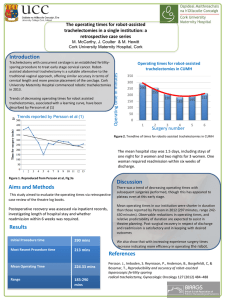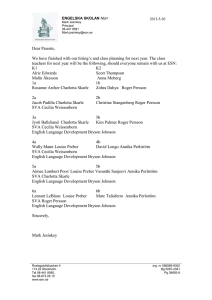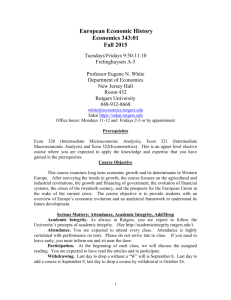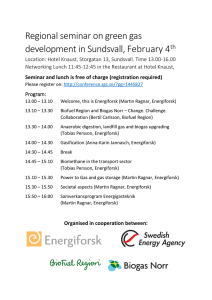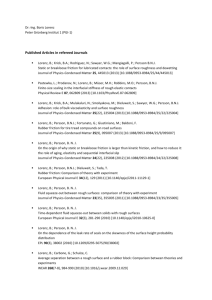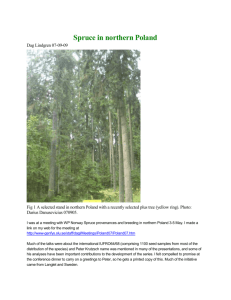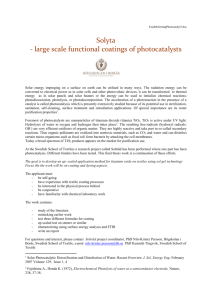Introduction - The-Family-Business-Lounge-2013
advertisement
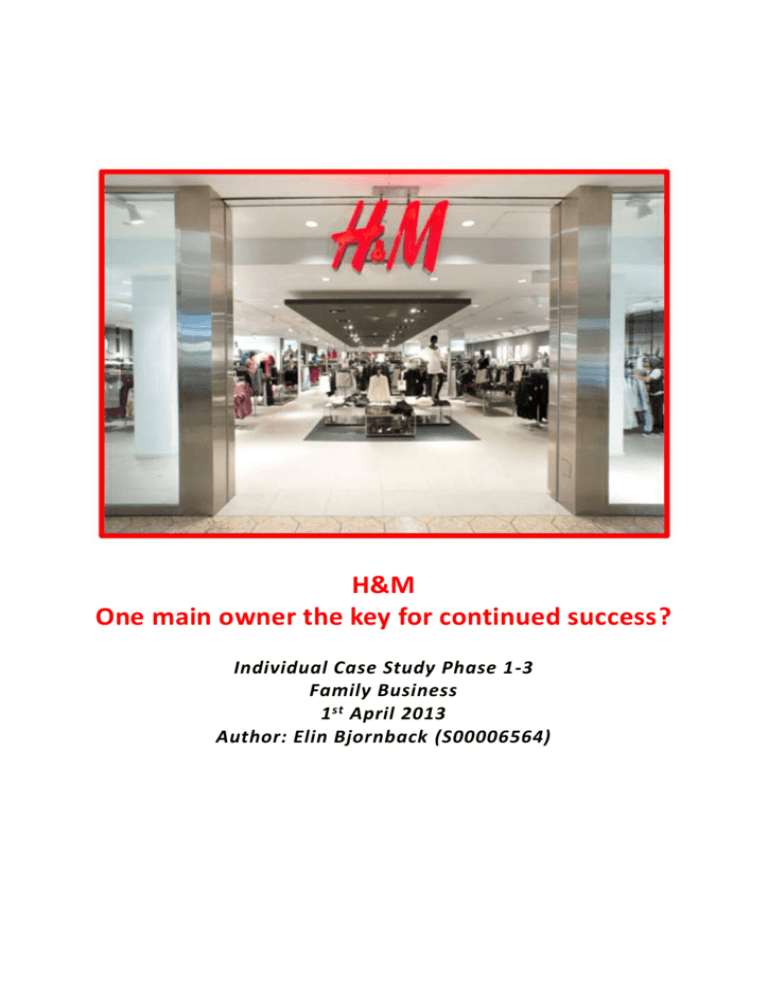
H&M One main owner the key for continued success? Individual Case Study Phase 1-3 Family Business 1 st April 2013 Author: Elin Bjornback (S00006564) Table of Contents INTRODUCTION .................................................................................................................................1 HOW IT ALL STARTED .....................................................................................................................1 KEY DATES ..........................................................................................................................................3 FAMILY AND OWNERSHIP..............................................................................................................3 FUTURE CONCERNS ..........................................................................................................................4 OWNERSHIP STRUCTURE ................................................................................................................................. 4 SHARED LEADERSHIP ....................................................................................................................................... 4 SUCCESSION, LEADERSHIP AND RESPONSIBLE OWNERSHIP BEHAVIOUR...................5 BIBLIOGRAPHY ..................................................................................................................................8 APPENDICES .......................................................................................................................................9 APPENDIX 1: BUSINESS DEVELOPMENT FROM IPO ...................................................................................... 9 APPENDIX 2: H&M GROUP 3 MONTH RESULTS (DEC 2012 – FEB 2013).......................................... 10 APPENDIX 3: FAMILY TREE.......................................................................................................................... 12 APPENDIX 4: OWNERSHIP STRUCTURE (10 LARGEST OWNERS) ............................................................. 13 Introduction H&M is the world’s second largest clothing retailer, after Spanish Inditex, with 2,800 stores in 48 countries and a total number of staff reaching 105,000 (H&M a, 2013, see appendix 1 for the development journey). The business idea of the Swedish fashion chain is to provide “fashion and quality at the best price”, selling clothes, accessories, shoes and beauty products for women, men, teens and children. The clothing lines are very diverse, including everything from basics to party outfits. In addition, H&M offers interior fashion through the concept H&M Home, which can be found in selected stores worldwide. In 2004, H&M became famous through introducing collaborations with high-end fashion designers. Unique and creative clothing- and accessories lines have since then been created together with Karl Lagerfeld, Stella McCartney, Versace and several others. The H&M Group also contains the more upscale fashion chain COS (Collection of Style), street fashion brands Weekday, Monki and Cheap Monday along with the newest concept & Other Stories. The sales for the first quarter (Q.1) of 2013 was SEK m 33 146 (around £3.3bn) and according to the report the company will open 350 new stores during the year and enter a new market, Australia, in 2014 (H&M b, see Appendix 2 for the latest financial figures). How it all started Erling Persson (b. 1917 in Västerås, Sweden) had never enjoyed school, mainly because he suffered from dyslexia, and early knew that he wanted to start his own business. At the age of 21, the son of two butcher shop owners, choose to move to Stockholm instead of taking over from his parents. Together with a close friend, Erling started to sell cheeses from his parents shop to local restaurants in the capital. The sales were good and after some months, the duo decided to buy and sell stock of diverse and cheap items, such as knifes to 1 restaurants, pens to offices and coffee machines to households. Without bank loans or other large sums of money, the two friends were successful in convincing people of their business excellence and managed to sell all of the items they bought with a profit under the name of “Carl Persson & Co” (Carl was Erling’s middle name). The business quickly gained good reputation and, through cleverness and superior business skills, the friends managed to get the exclusive rights to sell the MontBlanc pens in Sweden, which led to that bookstores became profitable customers. Because of that the pen business went well, the duo decided in 1943 to open a store called Pennspecialisten (English translation: The Pen Specialist), selling pens and stationary to both people and offices. While his friend moved on to become a book dealer, Erling decided to expand the store to include watches, and bought in a big stock of SEIKO watches, which became very successful and enabled an expansion to other cities in Sweden. In 1946, Erling wanted to seek new opportunities and travelled to USA. There he became fascinated about the concept with stores selling cheap but fashionable women’s wear. This concept had not yet reached Sweden so Erling quickly built close relationships with local American suppliers of clothes in order to go back to Sweden to fulfil his latest idea. In 1947, Erling opened a store called Hennes (means hers in Swedish) in his hometown of Västerås. It quickly became a success, mainly because the prices were 40% lower than other stores and Erling could soon open other stores in the country. In 1968, Erling wanted to include men’s clothing. He therefore bought a hunting chain called Mauritz Widforss, which gave him access to a large stock of men’s clothing and more store locations. He decided to merge the two names into one, creating Hennes & Mauritz (H&M). A red colour for the logo was chosen to more easily draw attention when expanding abroad in 1964 to Oslo, Norway. 2 Key Dates 1947 the first Hennes store opens in Västerås, selling women’s clothing. 1952 Hennes opens in Stockholm. 1964 The first store outside Sweden opens in Oslo, Norway. 1968 Erling Persson buys a hunting chain called Mauritz Widforss. Sales of men and children’s clothing start under the name of Hennes&Mauritz (H&M). 1974 H&M is listed on the Stockholm Stock Exchange. 1976 The first store outside Scandinavia opens in London, UK. 1982 Stefan Persson, Erling’s son, becomes CEO (until 1997) 2002 Erling Persson dies at a age of 85 2009 Karl-Johan Persson, Erling’s grandson, becomes CEO (until present) Family and Ownership H&M became public in 1974 in order to fund a more rapid expansion, however the founder Erling Persson remained the majority owner through only making B-shares available to the public. In Sweden, there are two types of shares in the market, A- and B shares. The A-share gives the owner more votes. In most cases, one B-share represents only 1/10 as many votes as one A- share. The H&M B-share is traded on the OMX Nordic Exchange Stockholm and the share capital consists of 194,400,000 A-shares (10 votes per share) and 1,460,672,000 Bshares (1 vote per share). The total number of shares is 1,655,072,000 (H&M c, 2013) Erling Persson had three children, two daughters and one son. During the 1980s, when his son Stefan Persson became CEO of H&M Erling allocated his shares in the business to his three children (see Appendix 3 for family tree). Even if the daughters received shares it was son Stefan who received the majority, becoming a single owner to all available A-shares. The daughters had declared no interest in the business and were instead given, in addition to Bshares, exclusive properties in central Stockholm as compensation. Today, Stefan Persson and his three children, there among son Karl-Johan Persson (CEO of H&M), are the majority owners of H&M, with 37.7% of the total shares and 69.7% of the total votes (see Appendix 4 for ownership structure). 3 Future Concerns Ownership Structure The main concern facing the Persson family and H&M is how the ownership structure will be shaped after the Chairman and main owner, Stefan Persson, chose to withdraw his position and making his three children full owners of the majority of the shares and votes, just like his father did during the 1980s. The family has been successful in both owning and managing the business into the third generation, but how can it best be continued? Have the strategy of having one main owner been the foundation for the success, or is it a combination of several factors? How can the siblings best protect the business and sustain healthy personal relationships in order to ensure prosperous ownership by the fourth generation? Shared Leadership The main owner of H&M, Stefan Persson, turned 65 years last year and he shows no signs of stepping down as the Chairman, a position he has held since 1998. His son, Karl-Johan Persson, has been CEO since 2009 and so far it seems that father and son have no problem working side by side, reflected in a good business performance. Shared leadership by family members can be frustrating, especially when two minds think different. What can be done to maintain a positive working relationship between father and son to avoid future tensions that could have a negative impact on the business? And how have father and son succeeded in managing H&M successfully together until now? 4 Succession, Leadership and Responsible Ownership Behaviour Berent-Braun and Uhlaner (2012) discuss in their study four different ownership behaviours: professionalism, active governance, owner as resource and basic duties. They purpose that ‘professionalism’ is the behaviour that secures positive financial performance. Through acting professional, the owner family shall not interfere with the business in any other way than decided and the two parts, family and business, is clearly separated. In a global enterprise like H&M, trust in the external management is of great importance if the owners are to be successful with creating good relationship between them. The Persson family has from the early beginning made sure that the business comes first, praising the employees and other shareholders for the rapid success. The strategy implemented by the founder Erling Persson to make one of his children the majority owner could be see as part of being professional by limiting interference by several family members in order to protect H&M in the long-run. Should it be continued or is there a way for his three grandchildren to remain equal owners? Succession has clearly not been an issue for the Persson family, which is now on the third generation. It could have much to do with the strong ethics held by the family that no member should be pushed into the business and that work experience from other businesses and industries are highly valued. In family business theory, the three-circle model ‘family, ownership and business’ take centre part in most discussions. It has to be harmony between the three dimensions in order for the family business to function well. However, when it comes to succession, there are more psychological factors that should be considered, as seen in the Psychological Field Model by Filser et al (2013) on page six. 5 How can the succession from Stefan Persson to his son Karl-Johan Persson be explained through using the model? Since it has been successful and the business is performing well, the issues, if any, could be more individual, with the Chairman Stefan Persson not able to let go of H&M to full extent and that they maybe do not have equal opinions on future strategies. According to Cater and Justis (2010) if shared leadership by the owner family of the business is to be prosperous, several factors need to be achieved. In addition to trust between the managing family members two-way communication and a shared understanding of the longterm strategy of the business are of great importance. Under the four years Karl-Johan Persson has been CEO the expansion phase of H&M has accelerated, adding 13 new markets between 2009-2012. This can be compared to the addition of only 5 markets under the more 6 passive strategy held by his father, Stefan Persson, during his period as CEO between 19821997. A more rapid expansion is needed if H&M is to remain competitive with Inditex, but does Chairman Stefan Persson fully agree with his son on this costly strategy, which can result in lower profit margins? 7 Bibliography Berent-Braun, M. and Uhlaner, L. (2012). ‘Responsible ownership behaviors and financial performance in family owned businesses’, Journal of Small Business and Enterprise Development, 19(1), pp. 20-38. Emerald Group Publishing Limited (online). Available at www.emeraldinsight.com. Accessed: 31 March 2013 Cater, J. and Justis, R. (2010). ‘The development and implementation of shared leadership in multi-generational family firms’, Management Research Review, 33(6), pp. 563-585. Emerald Group Publishing Limited (online). Available at www.emeraldinsight.com. Accessed 31 March 2013. Filser, M et al. (2013). ‘Psychological Aspects of Succession in Family Business Management’, Management Research Review, 36(3). Emerald Group Publishing Limited (online). Available at www.emeraldinsight.com. Accessed 31 March 2013 H&M a. (2013). About H&M. Available at: http://about.hm.com/content/hm/AboutSection/sv/About.html H&M b. (2013). Q1 Results. Available at: http://about.hm.com/content/hm/AboutSection/en/About/InvestorRelations/Financial-Reports/Financial-Reports.html#cm-menu H&M c. (2013). Ownership Structure. Available at: http://about.hm.com/AboutSection/en/About/Investor-Relations/TheShare/Ownership-Structure.html#cm-menu 8 Appendices Appendix 1: Business development from IPO 9 Appendix 2: H&M Group 3 Month Results (Dec 2012 – Feb 2013) 10 11 Appendix 3: Family Tree 12 Appendix 4: Ownership structure (10 largest owners) Lottie Tham is the sister of Stefan Persson. Jan Bengtsson is a nephew to Stefan Persson (son to his late sister). 13
